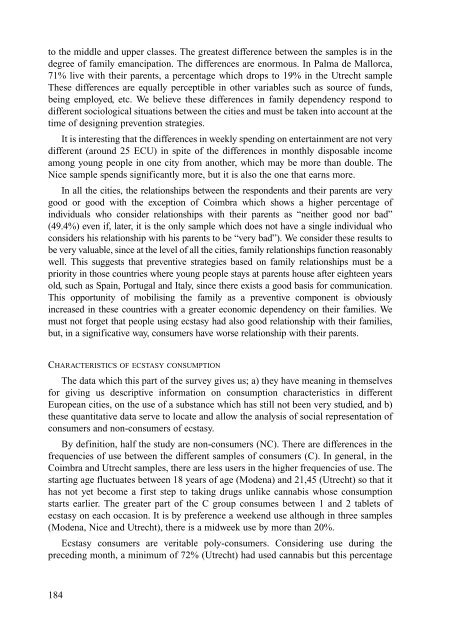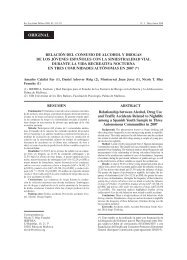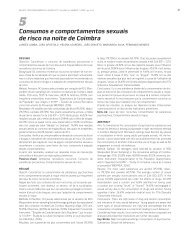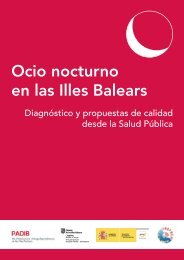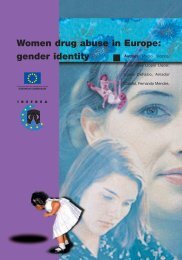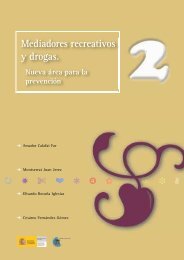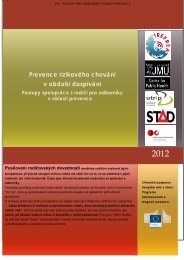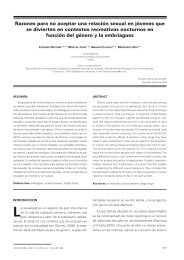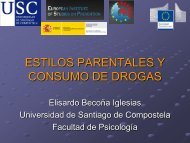Characteristics and social representation of ecstasy in Europe - Irefrea
Characteristics and social representation of ecstasy in Europe - Irefrea
Characteristics and social representation of ecstasy in Europe - Irefrea
You also want an ePaper? Increase the reach of your titles
YUMPU automatically turns print PDFs into web optimized ePapers that Google loves.
to the middle <strong>and</strong> upper classes. The greatest difference between the samples is <strong>in</strong> thedegree <strong>of</strong> family emancipation. The differences are enormous. In Palma de Mallorca,71% live with their parents, a percentage which drops to 19% <strong>in</strong> the Utrecht sampleThese differences are equally perceptible <strong>in</strong> other variables such as source <strong>of</strong> funds,be<strong>in</strong>g employed, etc. We believe these differences <strong>in</strong> family dependency respond todifferent sociological situations between the cities <strong>and</strong> must be taken <strong>in</strong>to account at thetime <strong>of</strong> design<strong>in</strong>g prevention strategies.It is <strong>in</strong>terest<strong>in</strong>g that the differences <strong>in</strong> weekly spend<strong>in</strong>g on enterta<strong>in</strong>ment are not verydifferent (around 25 ECU) <strong>in</strong> spite <strong>of</strong> the differences <strong>in</strong> monthly disposable <strong>in</strong>comeamong young people <strong>in</strong> one city from another, which may be more than double. TheNice sample spends significantly more, but it is also the one that earns more.In all the cities, the relationships between the respondents <strong>and</strong> their parents are verygood or good with the exception <strong>of</strong> Coimbra which shows a higher percentage <strong>of</strong><strong>in</strong>dividuals who consider relationships with their parents as “neither good nor bad”(49.4%) even if, later, it is the only sample which does not have a s<strong>in</strong>gle <strong>in</strong>dividual whoconsiders his relationship with his parents to be “very bad”). We consider these results tobe very valuable, s<strong>in</strong>ce at the level <strong>of</strong> all the cities, family relationships function reasonablywell. This suggests that preventive strategies based on family relationships must be apriority <strong>in</strong> those countries where young people stays at parents house after eighteen yearsold, such as Spa<strong>in</strong>, Portugal <strong>and</strong> Italy, s<strong>in</strong>ce there exists a good basis for communication.This opportunity <strong>of</strong> mobilis<strong>in</strong>g the family as a preventive component is obviously<strong>in</strong>creased <strong>in</strong> these countries with a greater economic dependency on their families. Wemust not forget that people us<strong>in</strong>g <strong>ecstasy</strong> had also good relationship with their families,but, <strong>in</strong> a significative way, consumers have worse relationship with their parents.CHARACTERISTICS OF ECSTASY CONSUMPTIONThe data which this part <strong>of</strong> the survey gives us; a) they have mean<strong>in</strong>g <strong>in</strong> themselvesfor giv<strong>in</strong>g us descriptive <strong>in</strong>formation on consumption characteristics <strong>in</strong> different<strong>Europe</strong>an cities, on the use <strong>of</strong> a substance which has still not been very studied, <strong>and</strong> b)these quantitative data serve to locate <strong>and</strong> allow the analysis <strong>of</strong> <strong>social</strong> <strong>representation</strong> <strong>of</strong>consumers <strong>and</strong> non-consumers <strong>of</strong> <strong>ecstasy</strong>.By def<strong>in</strong>ition, half the study are non-consumers (NC). There are differences <strong>in</strong> thefrequencies <strong>of</strong> use between the different samples <strong>of</strong> consumers (C). In general, <strong>in</strong> theCoimbra <strong>and</strong> Utrecht samples, there are less users <strong>in</strong> the higher frequencies <strong>of</strong> use. Thestart<strong>in</strong>g age fluctuates between 18 years <strong>of</strong> age (Modena) <strong>and</strong> 21,45 (Utrecht) so that ithas not yet become a first step to tak<strong>in</strong>g drugs unlike cannabis whose consumptionstarts earlier. The greater part <strong>of</strong> the C group consumes between 1 <strong>and</strong> 2 tablets <strong>of</strong><strong>ecstasy</strong> on each occasion. It is by preference a weekend use although <strong>in</strong> three samples(Modena, Nice <strong>and</strong> Utrecht), there is a midweek use by more than 20%.Ecstasy consumers are veritable poly-consumers. Consider<strong>in</strong>g use dur<strong>in</strong>g thepreced<strong>in</strong>g month, a m<strong>in</strong>imum <strong>of</strong> 72% (Utrecht) had used cannabis but this percentage184


